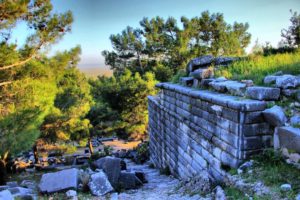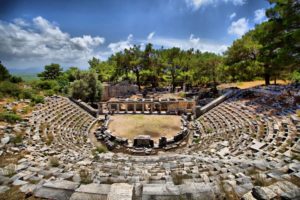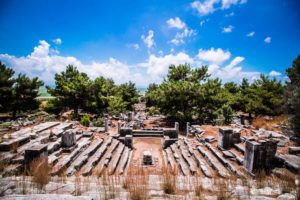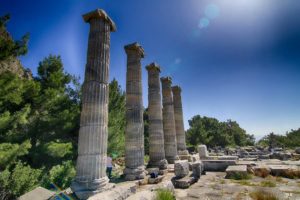The first example of urbanism and urban planning, the best preserved ancient city, the favorite of Alexander the Great: Priene
Priene is one of the best preserved ancient cities in Turkey with buildings remained standing and well-organized streets and alleys. It is one of the oldest settlements where urbanism and urban planning are applied. Most of the city has been unearthed during the 200 years of excavations.
The city, which was founded according to the plan of Hippodamos, the famous architect of Miletus, is the pioneer of today’s urbanism. The city contains technical details such as public buildings, civil houses, grid city planning, and presents the best examples of ancient architecture to its visitors.
In addition to the Temple of Athena, the holy stoa, the marketplace called the agora, the ancient theater and city planning are among the places to be seen in Priene.
According to the ancient geographical division of Anatolia, Mykale, the ancient name of Mykale, it is located on the southern foothills of the Samson Mountain.
Priene is in Gullubahce town of Soke, Aydin.
History of the City
The earliest material remains of the ancient city of Priene go back to the Archaic period. According to ancient Greek sources such as Pausanias, Priene was first established by the Ionians who had been mixed with Thebailis in a place we do not know today. Formerly a port city, the city began to lose its strength with the accumulation of alluvial deposits of the Menderes River and the withdrawal of the sea.
In Priene Antique City, in the first three centuries after its foundation, because of its high level of prosperity, spectacular public buildings and temples were built with marble and marble in consideration of long construction periods. It is known that the newly founded city of Priene was a “city state” with a democratic structure in the ancient period.
The main source of livelihood of the city was agriculture rather than trade. Irrigation of the fields in agricultural production was provided by the Menderes River. The Menderes River has always played such a decisive role in the life and livelihoods of the city that the Priens stylized this fateful river as the “Maeander strip”, and put it on the back of the coins.
Priene is also the hometown of the famous philosopher and jurist Bias in the 6th century BC, saying, “ Win the majority by persuading, not by bad or brutal force! “.
Also known as the favorite of Alexander the Great, there is a house where the emperor stayed for a long time. The Temple of Athena, which exhibits a characteristic example of the Ionian temples, was built by Pytheas, the architect of Halicarnassus Mausoloumu, one of the seven wonders of the world in ancient times.
Research History
The scientific archaeological excavations and researches in Priene have been continued by Bursa Uludag University Archeology Department since 2018 which was initiated by England in 1750. The main focus of the excavations in the new period is to investigate the necropolis and grave structures of the city. The restoration work continues in the western part of the northern part of the agora known as the “Holy Stoa”.
Athena Polias Sanctuary
Athena, the protector and mother goddess of the Priene City State, had the title “Polias olan, which derives from the word“ police ”(city). The Athena Sanctuary, according to its importance, has the largest” temenos” area in the city. It is also the first sanctuary built after the establishment of the new site. A high terrace was chosen as the location of the temple, which would make it more dominant than the other areas around it, and thus could be seen from the Menderes Plain and even from the sea (considering the situation in antiquity).
Theater
The theater structure in Priene is an important example of its genre because it has been preserved in its Hellenistic form without any change in the late periods. The capacity of the audience seats is assumed to be approximately 6,500 people. The orchestra where the games are played is limited by specially arranged honor seats for the important personalities of the city. On the middle edge of the same area is a marble altar dedicated to the Theater God Dionysus.
Prytaneion and Bouleuterion (Parliament Building)
These two structures are located in the northeastern part of the agora in the city center, both of which are administrative public structures related to the administration of the city. In Bouleuterion, the people’s assembly convened.
The first phase of the building in Priene was probably built in 200 BC. 500 members of the assembly gathered in the structure, taking decisions. In the middle of the Bouleuterion is an altar with god busts.
Agora
The agora, the heart of the police (city-state) as well as a kind of “history book etmek, occupies almost the central part of the city area in Priene. This was a closed area in time. The Priene Agora should not be a commercial center or a marketplace, but rather a “space” for festivals and political discussions of citizens. Thus the agora was ostentatiously equipped. The influential people of the city competed with each other in order to be represented by a statue or a monument of honor.
Residential Areas in the West and Northwest
There are large quarters with residences in the Western Gate Street and Theater Street in the western part of the ancient city. These neighborhoods have been subjected to a fire disaster of unknown origin in the 2nd century BC. After this incident, these housing areas were never used again, with a few exceptions. In the second half of the 2nd century BC, large rock fragments from the acropolis were ruptured. These gigantic rocks still stand between the walls of the houses.
Transportation
You can get to the ancient city from Soke by private car or taxi, or you can take advantage of Didim buses departing from Aydin city center.
Entrance
It is open to visitors every day of the week between 08.30-17.30 in winter and 08.00-19.00 in summer. The Museum card is valid at the Priene Archaeological Site, but the entrance fee is 6 TL for 2019 for those who do not have a Museum card.





